9.2 Residents' Survey
The volunteers who delivered the surveys to householders left one Residents' Survey for each person in the household aged 18 or over.
9.2.1 About You
The residents' survey began by asking which village the respondent lived in, in order to allow us to analyse the results by village and thus establish where there were significant differences between each location. The total of responses from each village is shown in the table below:
|
Great Bealings |
Little Bealings |
Playford |
|
138 |
256 |
126 |
In total 531 surveys were returned (this is higher than the sum of the figures above, since some residents did not answer the question about their village). It is not possible to be precise about the percentage return for residents since we don't have an exact figure for the number of adults in the villages. However, the demographic information from the household survey allows us to estimate that there are 1.94 adults per house. Given the knowledge that there are 397 properties, then the return of 531 surveys is a 69% return, exactly the same as for the household survey.
We started by asking the respondent's gender and found that 53% were female and 47% male, very close to the regional figures of 52%/48%.
We then asked about employment status. The results are shown in the diagram below, contrasted with those from Suffolk Coastal as a whole (taken from the 2001 Census results).
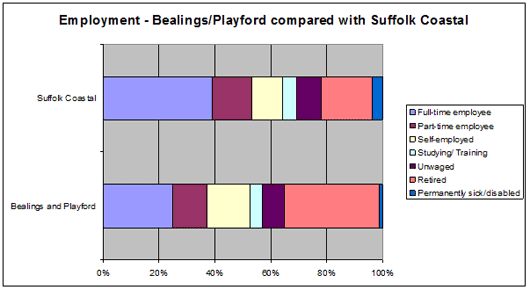
As can be seen, the 3 villages have substantially fewer people in full-time employment than is normal for Suffolk Coastal. There are, however, almost twice as many retired people than the average for the district.
We asked whether respondents considered themselves disabled. 23 residents told us that they did, which is 5% of the residents of the villages. This is much lower than the rest of Suffolk, where the County Council reports that 12.6% of working age people have a disability.
We then asked how long residents had lived in their current home and received the responses in the chart below.
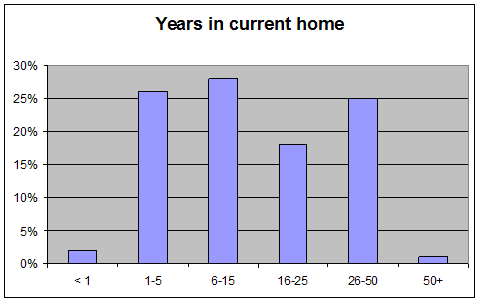
As we see, over a ¼ of the residents have lived here for over a quarter of a century - so we have a pretty stable population!
We then looked at communications with the villagers and started by asking how often they read the Benefice newsletter.
|
Every month |
Most issues |
Occasionally |
Never |
|
58% |
16% |
16% |
10% |
This shows a high percentage of residents rely on the newsletter for local news and emphasises that it can be a very good way of communicating things to them such as local events, Parish Council news, ways of reporting problems, etc.
We also asked how often they looked at the villages' websites.
|
Once a week |
Once a month |
Less often |
Never |
|
1% |
4% |
23% |
72% |
So it's clear that, at present, the websites are less effective at communicating with villagers and that this needs improving.
Action 4 Work with Benefice Newsletter to improve communication e.g. of Village Hall events, Parish Council communication, bus timetables, fly tipping/road repair/footpath maintenance reporting, car sharing, crop spraying, young people's events. Work with PCs to improve and promote websites. Consider using the Suffolk Association of Local Councils' "e-communities" initiative as a communications mechanism.
9.2.2 Housing and Development
This section started by asking residents what sort of development they supported in or adjacent to their village. There was most support for smaller housing and sheltered accommodation for the elderly. 45% strongly opposed light industrial and a further 30% opposed it. The results for this are illustrated in the chart below.
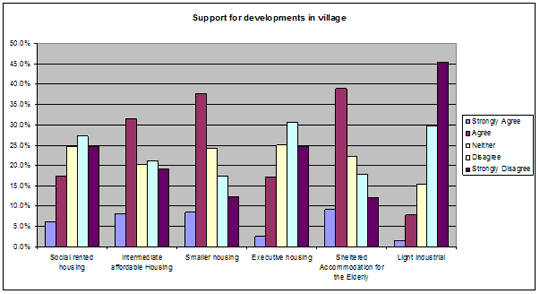
When asked whether they had a need for housing developments, 19 residents strongly agreed that they had a need for "Smaller Housing" and 17 for "Sheltered Accommodation for the Elderly".
Action 5 Parish Councils to consider data from Parish Plan in development planning policy and keep under review the need for further housing surveys.
There was a strong demand to retain green fields between Kesgrave and Playford/Bealings, with 73% strongly agreeing with this. Of all the questions in the survey, this was the one most strongly agreed with.
Action 6 Work with SCDC and PCs to progress retention of green fields between Kesgrave and Playford/Bealings.
Comments on the surveys showed a strong resistance to development of any kind in the villages, although there was also some support for limited housing development, in particular affordable housing or units for older people, if need could be shown. Industrial development of any kind was opposed.
9.2.3 Local Services (e.g. electricity, gas, recycling, fire, ambulance etc)
There was strong demand for better provision of recycling bins for plastic/glass/metal, etc., with 77% either agreeing or strongly agreeing with this requirement. It is worth noting that since the survey (and incidental to it), the local council has introduced improved recycling collections for some of the 3 parishes, although this does not include glass.
Action 7 Investigate recycling sites and liaise with SCDC concerning wider provision.
The other questions generating the strongest agreement were for electricity and phone cables to be underground (62% agree/strongly agree) and support for a community village shop (run by volunteers) (52% agree/strongly agree - numerically over 100 villagers strongly agreed with this suggestion).
Action 8 Pursue placing cables underground with service providers.
Action 9 Explore community village shop with interested residents.
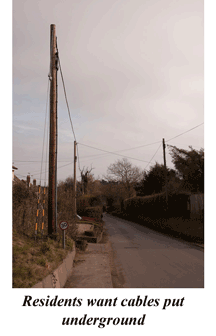 Support
for improved mobile phone coverage was (not surprisingly) strongly related
to postcode. For example, in postcode IP16 6PG (Grundisburgh Road, Great
Bealings) 66% (6 out of 9 respondents) strongly agreed that they need
improved mobile phone coverage. However, in IP13 6PL (Holly Close, Little
Bealings) 71% (5 out of 7) disagreed that they need better coverage. This
is covered in more detail in the Young Residents' survey - see Action
15.
Support
for improved mobile phone coverage was (not surprisingly) strongly related
to postcode. For example, in postcode IP16 6PG (Grundisburgh Road, Great
Bealings) 66% (6 out of 9 respondents) strongly agreed that they need
improved mobile phone coverage. However, in IP13 6PL (Holly Close, Little
Bealings) 71% (5 out of 7) disagreed that they need better coverage. This
is covered in more detail in the Young Residents' survey - see Action
15.
Other questions that the residents supported were for improved notice of events in the Benefice Newsletter (see Action 4) and keeping public phone boxes open/working. However, on the latter issue, BT has shown that the Great Bealings phone box, for example, had zero revenue in the previous year (i.e. no-one used it to make a paying call). The steering group therefore felt they should not pursue this further.
There was little support for:
- another pub in the 3 parishes
- village allotments
- visiting Doctors' Surgery/nurse in the village
- community internet access
- a community wind turbine for electricity
- a "Carbon Footprint" audit of fuel used in village
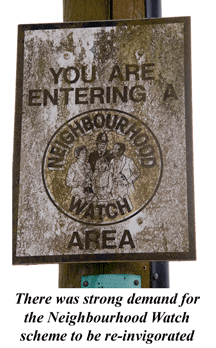 Comments
mentioned a desire to improve ecology-related items such as recycling
bins, solar panels on community buildings and a water turbine for electricity.
A fuel collective to reduce the number of deliveries and improve discounts
was also suggested (see Action 1).
Comments
mentioned a desire to improve ecology-related items such as recycling
bins, solar panels on community buildings and a water turbine for electricity.
A fuel collective to reduce the number of deliveries and improve discounts
was also suggested (see Action 1).
9.2.4 Security of Persons and Property
There was strong demand for the Neighbourhood Watch scheme to be publicised or re-invigorated, with 81% of respondents supporting this. 69% of villagers also believe that there should be a police officer regularly patrolling the village.
Only 18% of villagers found the mobile police van useful, with this percentage dropping to just 9% in Playford. Comments frequently mentioned a lack of knowledge of the mobile van.
Action 10 Work with police, Neighbourhood Watch co-ordinators and local residents to reinvigorate Neighbourhood Watch and improve understanding of police presence.
There was general support for better lighting in the village hall car parks, although this is mainly an issue for Great Bealings residents, with 59% in favour, whereas in Playford there is just 29% in favour. Almost half of the residents of all parishes thought that there should be warning notices to secure cars at the village hall.
Action 11 Work with Village Hall Management Committees to improve lighting and warning notices.
9.2.5 Issues for People with mobility difficulties
We then asked whether residents had mobility difficulties and 28 said that they did. We asked these residents to say whether they would like any particular forms of help. (Note that a number of people who said they did not have mobility difficulties also answered questions which were only intended for those who did. These answers were deleted from the database prior to this analysis.) Most respondents did not require help, but there was a significant number of people who said that they would like extra help with some activities - gardening/mowing being the most requested, with 18 people saying they needed this. Others would like help with shopping and housekeeping. A local lunch club or keep-fit club were also popular suggestions.
Action 12 Work with residents, Suffolk ACRE and local charities (e.g. Age Concern) to exchange information and arrange services for people with mobility problems.
9.2.6 Issues for Young People (12-17)
Finally, residents were asked what they believed were issues for the young people in the villages. 83% believe that cycling/walking in the village is dangerous for children and 82% think that young people need safe foot/cycle paths to the playing field. Both of these issues are most strongly felt by residents of the Bealings. These issues are covered under Action 26 and Action 27.
There was a strong feeling that village teams (e.g. football) should be encouraged, with 84% of villagers supporting this.
Action 13 Work with those interested to set up and run local teams.
66% felt that more activities for young people should be held in the village hall, with 35% believing that a film club would be a good option.
Action 14 Develop existing Playford provision for film club.
9.2.7 Other Comments
The residents made a number of general comments and the list of these can be found in Appendix A.